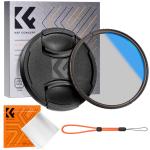
72mm CPL Filter Circular Polarizer Filter with Lens Cap Optical Glass Ultra Slim 18 Multi-Layer for Camera Lens Nano-Klear
SKU: KF01.1316V5
The most important thing first: I have been planning to buy a polarizing filter for a while, but the K&F filter was my first. So I have no experience and little opportunity to compare it to competitors. This review therefore reflects the experiences of a beginner in this field. Delivery: The filter is delivered in a relatively large plastic box together with a lens cap, a wrist strap and a cleaning cloth. Unfortunately, the filter is loose in the box, which means it slides back and forth during transport. If the lens cap is on, however, this should theoretically not cause any scratches on the filter, especially since there is still air between the filter and the box on the back due to the thread. Unfortunately, the K&F lens cap sits very loosely on the filter, and falls off at the slightest touch. My original protective cap from the Tamron lens sits much better on the filter than the cap from K&F. Installation and handling: The filter is quickly screwed onto the appropriate lens. In my case, this is a Tamron 11-20mm wide-angle lens. The first few times I tried, the filter was so tight that I couldn't get it off again. Over the course of subsequent photo tours, it must have become loose due to frequent adjustments, so that once it almost fell off the lens when I was adjusting the filter. The correct fit of the filter should therefore be checked regularly. The filter definitely scores points in other areas too: thanks to the very good and precise workmanship, the filter also provides perfect dust and scratch protection. I tested the filter and lens extensively on the beach in all weathers and the dust could be wiped off the filter without any problem. No dust got between the filter and the lens. My lens is also splash-proof, but I didn't want to test whether the filter would let water through. What is annoying is the lens's lens hood. But that shouldn't be interpreted negatively as the sun protection is designed differently for each lens and is also removable. With my Tamron, you would need very slim fingers to adjust the filter with the lens hood screwed on. Image quality: Basically, you have to know that a polarizing filter absorbs some light, which makes the photos a little darker than you might be used to. If you often take photos with manual settings, you will be able to compensate for this. However, I have problems with the automatic settings on my camera (Sony ZV-E10), which sometimes doesn't seem to recognize the brightness and contrast correctly. This can be corrected in post-processing, however. Reflections can be removed wonderfully with the filter - simply turn the filter to the desired intensity. It must be said that a filter of this type is only suitable to a limited extent for quick photos taken from the hip. Every subject needs a different intensity. By the time you have set the filter, the desired subject may have long since changed. But professional photographers know that photography requires patience. I recently got a polarizing filter that I can attach to my cell phone, also from K&F. It has a mark on the edge showing the intensity you have set. I would also like a scale like this for this filter, so that I can reproduce subjects later without a lot of trial and error. Sometimes you accidentally touch the ring when taking photos and adjust it. Then you have to laboriously search for what you had set. In theory, a polarizing filter also increases the color saturation. You know this from sunglasses, where grass suddenly looks much greener (and you can no longer see cell phone displays). Of course, this depends a lot on the subject and the settings on the camera and filter. If you take a little time, you can conjure up great photos here.
27/02/2024
I've tried it out now. Can't complain. Great accessories and perfect for my application.
15/02/2024
